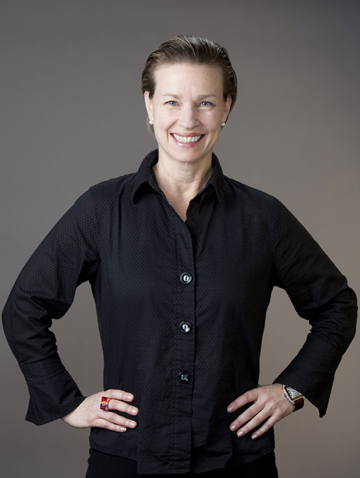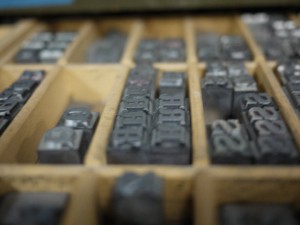A Q&A with Professor Gloria Kondrup, Archetype Press Director

Gloria Kondrup
How did Art Center’s Archetype Press come about?
Archetype Press was founded in 1989 with more than 2,500 drawers of rare American and European foundry type, wood type and ornaments from the collection of Los Angeles typographer and printer Vernon Simpson.
The support from Art Center’s then-president David Brown, the financial backing of five patrons, and the hard work of the founding Archetype Press Director Vance Studley was crucial to its creation. Before coming to its current home at South Campus, Archetype was located on Mills Place in Pasadena. This was before the retail revival of Old Pasadena—most of Colorado Boulevard was boarded up, and finding parking was never a concern.
What role have you played in relation to Archetype?
I discovered Archetype Press and letterpress printing in 1992 as a graduate student at Art Center. Although my design background was in branding and packaging, I found the letterpress experience authentic and tactile. After graduation, I purchased my own presses and established a design studio that straddled both 15th and 21st century technologies.
 In 2003, I was given the opportunity to become director of Archetype. In one sense, I view my responsibility as stewardship for the preservation of language and of a cultural artifact while enhancing students’ ability to understand the relationship of language and imagery.
In 2003, I was given the opportunity to become director of Archetype. In one sense, I view my responsibility as stewardship for the preservation of language and of a cultural artifact while enhancing students’ ability to understand the relationship of language and imagery.
People are often surprised that Art Center teaches students to use this “outdated technology.” What is your response to that?
Archetype continues the tradition of an older—but not outdated—technology. While letterpress is steeped in tradition, Archetype is not nostalgic.
As an experimental typographic workshop, students don’t just study the prototypes of digital letterforms, but are exposed to a sensual graphic experience that is both felt and seen as type is inked and pressed into a piece of paper. They are getting ink underneath their fingernails, not merely replacing ink cartridges in color printers. They are being challenged to expand beyond the margins of the computer screen, engaging in a design discourse that can question the uses of newer technologies.
Without question, digital technologies are the preferred way for the efficient exchange and dissemination of information. But digital technology has also allowed letterpress printing to change and explore new ways of combining image and text.
What is the most unique aspect of Archetype Press?
Archetype Press offers Art Center students the opportunity to learn and practice what has become a rarity: setting type and printing by hand. The dedication of space, resources and support that the College has given the press, and the fluid integration with its Graphic Design program and curriculum, has been outstanding. I am not aware of any other university or college in the country with anything as extensive. This has afforded Archetype to have many different instructors who offer a rich variety of talents and narratives to our students.
What are some of the more creative projects you’ve seen emerge from Archetype Press?
I am constantly amazed at the talent Art Center students possess. Almost every term, students participate in a collaborative book project. Each student contributes an individually designed page based on a single theme. Past publications have addressed the works of traditional and contemporary writers, language and typography, as well as relevant and social issues. As limited editions, a small number are sold to institutions and private collectors.
This is a very important source of income for Archetype. The sales from one edition are used to help cover the cost of the next. Some of our most recent editions, and some of my favorites, have been ”21” Archetype Mixers, a bar recipe book with a twist of type, Brother Can you Spare a Dime, Typographic Interpretations of Songs of the Great Depression, and our most recent publication, Archetype Sideshows. One of our most innovative classes has been Type Slam, exploring typography and printing as a performance.
Students aren’t the only ones exploring their creative side with Archetype. Who else has access to the press?
While Archetype’s main educational purpose is dedicated to Art Center’s degree programs, we believe it is important to serve as a conduit for the exchange of ideas between educational and professional institutions, as well as the greater community at large. We strive to enhance the understanding of typography, print culture and the book arts.
In addition to courses offered through the College’s Public Programs Art Center at Night and Saturday High, Archetype has been a resource for other universities, high schools and Art Center patron groups, offering tours, demonstrations and even week-long workshops.
 What do you have planned for your 21st anniversary celebration?
What do you have planned for your 21st anniversary celebration?
We will be holding an anniversary event on Saturday, Oct. 2, at South Campus. It will be a celebration of the present, and an affirmation of the next 21 years. It is time to clean out the flat files, storage bins and book coffers to make room for new work being generated, so books, broadsides and ephemera produced by Archetype will be for sale. We will have all of the limited edition books, now in excess of 50, produced by the press on display as well. All proceeds will benefit Art Center’s 80 for 80 scholarship initiative.
What do you see in the future for Archetype Press?
Unfortunately, the foundry metal type will eventually wear out, become lost or destroyed. But as education continues the digital march forward, the process of letterpress printing will hopefully remain a valuable technology in the study of typography and language, and conventional printing process will continue through the integration photopolymer plates that are digitally created. I see us moving toward a more fluid exchange between the technologies.
And in another 21 years from now, or maybe even 100 years, someone might come across a phrase that has been inked and pressed into a piece of paper, and we will be remembered.
Follow Archetype Press on Facebook.







